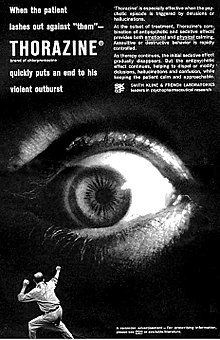Chlorpromazine
Appearance
(Redirected from Thorazine)
 | |
 | |
| Clinical data | |
|---|---|
| Trade names | Largactil, Thorazine, many others |
| AHFS/Drugs.com | Monograph |
| MedlinePlus | a682040 |
| License data |
|
| Pregnancy category |
|
| Routes of administration | Oral (tablets and syrup available), rectal, IM, IV infusion |
| ATC code | |
| Legal status | |
| Legal status |
|
| Pharmacokinetic data | |
| Bioavailability | 10–80% (Oral; large interindividual variation)[1] |
| Protein binding | 90–99%[1] |
| Metabolism | Liver, mostly CYP2D6-mediated[1] |
| Elimination half-life | 30 hours |
| Excretion | Urine (43–65% in 24 hrs)[1] |
| Identifiers | |
| |
| CAS Number | |
| PubChem CID | |
| IUPHAR/BPS | |
| DrugBank | |
| ChemSpider | |
| UNII | |
| KEGG | |
| ChEBI | |
| ChEMBL | |
| ECHA InfoCard | 100.000.042 |
| Chemical and physical data | |
| Formula | C17H19ClN2S |
| Molar mass | 318.86 g/mol (free base) 355.33 g/mol (hydrochloride) |
| 3D model (JSmol) | |
| |
| |
| (verify) | |

Chlorpromazine, also known by its trade name Thorazine, is an antipsychotic drug. It is typically used to treat Schizophrenia. It has also been used to treat bipolar disorder. It has been shown to help uncontrollable hiccups disappear. It is also used to help with nausea and vomiting.[2] Chlorpromazine was developed in 1950, making it the oldest antipsychotic drug.[3]
References
[change | change source]- ↑ 1.0 1.1 1.2 1.3 "PRODUCT INFORMATION LARGACTIL" (PDF). TGA eBusiness Services. Sanofi Aventis Pty Ltd. 28 August 2012. Archived from the original on 30 March 2017. Retrieved 8 December 2013.
- ↑ "ChlorproMAZINE Monograph for Professionals". Drugs.com. Retrieved 2022-09-22.
- ↑ López-Muñoz, Francisco; Alamo, Cecilio; cuenca, Eduardo; Shen, Winston; Clervoy, Patrick; Rubio, Gabriel (2005-07-01). "History of the Discovery and Clinical Introduction of Chlorpromazine". Annals of Clinical Psychiatry. 17 (3): 113–135. doi:10.1080/10401230591002002. ISSN 1040-1237. PMID 16433053.
